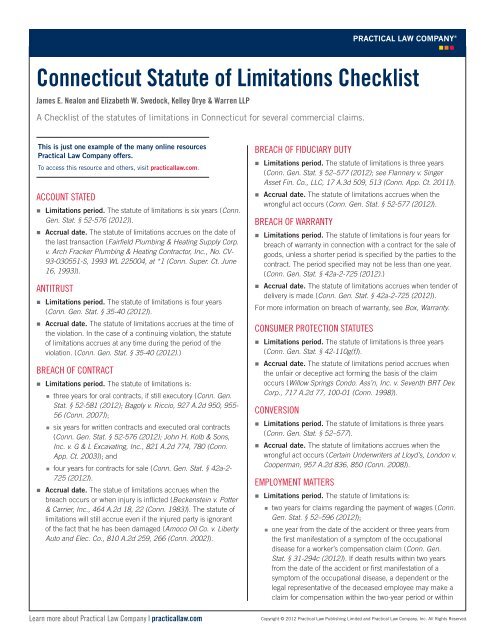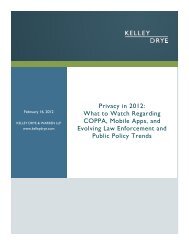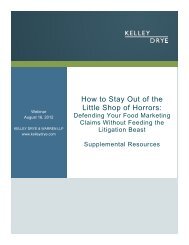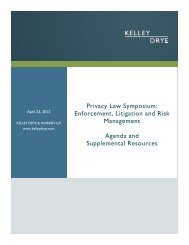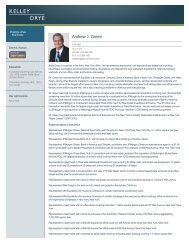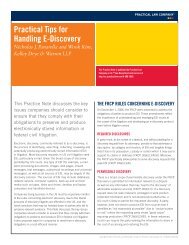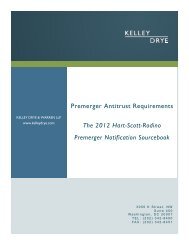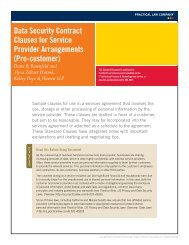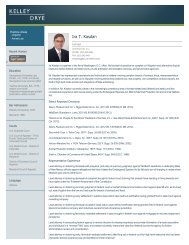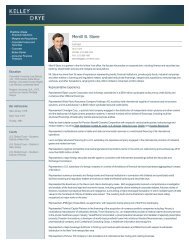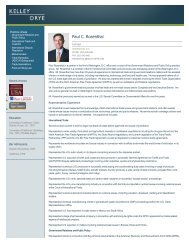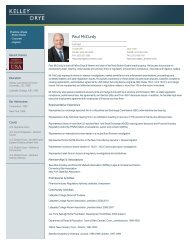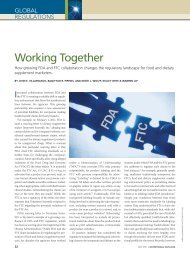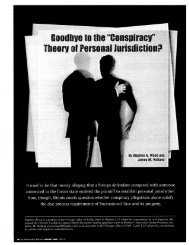Connecticut Statute of Limitations Checklist - Kelley Drye
Connecticut Statute of Limitations Checklist - Kelley Drye
Connecticut Statute of Limitations Checklist - Kelley Drye
Create successful ePaper yourself
Turn your PDF publications into a flip-book with our unique Google optimized e-Paper software.
<strong>Connecticut</strong> <strong>Statute</strong> <strong>of</strong> <strong>Limitations</strong> <strong>Checklist</strong><br />
James E. Nealon and Elizabeth W. Swedock, <strong>Kelley</strong> <strong>Drye</strong> & Warren LLP<br />
A <strong>Checklist</strong> <strong>of</strong> the statutes <strong>of</strong> limitations in <strong>Connecticut</strong> for several commercial claims.<br />
This is just one example <strong>of</strong> the many online resources<br />
Practical Law Company <strong>of</strong>fers.<br />
To access this resource and others, visit practicallaw.com.<br />
ACCOUNT STATED<br />
• <strong>Limitations</strong> period. The statute <strong>of</strong> limitations is six years (Conn.<br />
Gen. Stat. § 52-576 (2012)).<br />
• Accrual date. The statute <strong>of</strong> limitations accrues on the date <strong>of</strong><br />
the last transaction (Fairfield Plumbing & Heating Supply Corp.<br />
v. Arch Fracker Plumbing & Heating Contractor, Inc., No. CV-<br />
93-030551-S, 1993 WL 225004, at *1 (Conn. Super. Ct. June<br />
16, 1993)).<br />
ANTITRUST<br />
• <strong>Limitations</strong> period. The statute <strong>of</strong> limitations is four years<br />
(Conn. Gen. Stat. § 35-40 (2012)).<br />
• Accrual date. The statute <strong>of</strong> limitations accrues at the time <strong>of</strong><br />
the violation. In the case <strong>of</strong> a continuing violation, the statute<br />
<strong>of</strong> limitations accrues at any time during the period <strong>of</strong> the<br />
violation. (Conn. Gen. Stat. § 35-40 (2012).)<br />
BREACH OF CONTRACT<br />
• <strong>Limitations</strong> period. The statute <strong>of</strong> limitations is:<br />
• three years for oral contracts, if still executory (Conn. Gen.<br />
Stat. § 52-581 (2012); Bagoly v. Riccio, 927 A.2d 950, 955-<br />
56 (Conn. 2007));<br />
• six years for written contracts and executed oral contracts<br />
(Conn. Gen. Stat. § 52-576 (2012); John H. Kolb & Sons,<br />
Inc. v. G & L Excavating, Inc., 821 A.2d 774, 780 (Conn.<br />
App. Ct. 2003)); and<br />
• four years for contracts for sale (Conn. Gen. Stat. § 42a-2-<br />
725 (2012)).<br />
• Accrual date. The statue <strong>of</strong> limitations accrues when the<br />
breach occurs or when injury is inflicted (Beckenstein v. Potter<br />
& Carrier, Inc., 464 A.2d 18, 22 (Conn. 1983)). The statute <strong>of</strong><br />
limitations will still accrue even if the injured party is ignorant<br />
<strong>of</strong> the fact that he has been damaged (Amoco Oil Co. v. Liberty<br />
Auto and Elec. Co., 810 A.2d 259, 266 (Conn. 2002)).<br />
BREACH OF FIDUCIARY DUTY<br />
• <strong>Limitations</strong> period. The statute <strong>of</strong> limitations is three years<br />
(Conn. Gen. Stat. § 52–577 (2012); see Flannery v. Singer<br />
Asset Fin. Co., LLC, 17 A.3d 509, 513 (Conn. App. Ct. 2011)).<br />
• Accrual date. The statute <strong>of</strong> limitations accrues when the<br />
wrongful act occurs (Conn. Gen. Stat. § 52-577 (2012)).<br />
BREACH OF WARRANTY<br />
• <strong>Limitations</strong> period. The statute <strong>of</strong> limitations is four years for<br />
breach <strong>of</strong> warranty in connection with a contract for the sale <strong>of</strong><br />
goods, unless a shorter period is specified by the parties to the<br />
contract. The period specified may not be less than one year.<br />
(Conn. Gen. Stat. § 42a-2-725 (2012).)<br />
• Accrual date. The statute <strong>of</strong> limitations accrues when tender <strong>of</strong><br />
delivery is made (Conn. Gen. Stat. § 42a-2-725 (2012)).<br />
For more information on breach <strong>of</strong> warranty, see Box, Warranty.<br />
CONSUMER PROTECTION STATUTES<br />
• <strong>Limitations</strong> period. The statute <strong>of</strong> limitations is three years<br />
(Conn. Gen. Stat. § 42-110g(f)).<br />
• Accrual date. The statute <strong>of</strong> limitations period accrues when<br />
the unfair or deceptive act forming the basis <strong>of</strong> the claim<br />
occurs (Willow Springs Condo. Ass’n, Inc. v. Seventh BRT Dev.<br />
Corp., 717 A.2d 77, 100-01 (Conn. 1998)).<br />
CONVERSION<br />
• <strong>Limitations</strong> period. The statute <strong>of</strong> limitations is three years<br />
(Conn. Gen. Stat. § 52–577).<br />
• Accrual date. The statute <strong>of</strong> limitations accrues when the<br />
wrongful act occurs (Certain Underwriters at Lloyd’s, London v.<br />
Cooperman, 957 A.2d 836, 850 (Conn. 2008)).<br />
EMPLOYMENT MATTERS<br />
• <strong>Limitations</strong> period. The statute <strong>of</strong> limitations is:<br />
• two years for claims regarding the payment <strong>of</strong> wages (Conn.<br />
Gen. Stat. § 52–596 (2012));<br />
• one year from the date <strong>of</strong> the accident or three years from<br />
the first manifestation <strong>of</strong> a symptom <strong>of</strong> the occupational<br />
disease for a worker’s compensation claim (Conn. Gen.<br />
Stat. § 31-294c (2012)). If death results within two years<br />
from the date <strong>of</strong> the accident or first manifestation <strong>of</strong> a<br />
symptom <strong>of</strong> the occupational disease, a dependent or the<br />
legal representative <strong>of</strong> the deceased employee may make a<br />
claim for compensation within the two-year period or within<br />
Learn more about Practical Law Company | practicallaw.com<br />
Copyright © 2012 Practical Law Publishing Limited and Practical Law Company, Inc. All Rights Reserved.
<strong>Connecticut</strong> <strong>Statute</strong> <strong>of</strong> <strong>Limitations</strong> <strong>Checklist</strong><br />
one year from the date <strong>of</strong> the employee’s death, whichever<br />
is later (Chambers v. Elec. Boat Corp., 930 A.2d 653, 658<br />
(Conn. 2007)); and<br />
• 180 days for filing a discrimination claim under the<br />
<strong>Connecticut</strong> Fair Employment Practices Act with<br />
the <strong>Connecticut</strong> Commission on Human Rights and<br />
Opportunities (CHRO) (Conn. Gen. Stat. § 46a-82 (2012)).<br />
However, a plaintiff must file a claim for discrimination<br />
related to past convictions within 30 days (Conn. Gen. Stat.<br />
§ 46a-80 (2012)). A plaintiff must also file a complaint with<br />
the CHRO before bringing suit in court (Conn. Gen Stat. §<br />
46a-82 (2012); Dembinski v. Pfizer, Inc., 628 F. Supp. 2d<br />
267, 271 (D. Conn. 2009)).<br />
• Accrual date. The statute <strong>of</strong> limitations accrues for:<br />
• wage claims when an employer refuses to compensate<br />
employee according to terms <strong>of</strong> an express or implied<br />
employment contract (Warzecha v. Nutmeg Companies,<br />
Inc., 48 F. Supp. 2d 151, 158 (D. Conn. 1999)). However,<br />
the accrual <strong>of</strong> the statute <strong>of</strong> limitations may be tolled if the<br />
employee files a claim with the Labor Commissioner (Conn.<br />
Gen. Stat. § 52–596 (2012));<br />
• workers’ compensation claims on the date <strong>of</strong> the accident or<br />
first manifestation <strong>of</strong> a symptom <strong>of</strong> the occupational disease<br />
(Conn. Gen. Stat. § 31-294c (2012)); and<br />
• a discrimination claim on the date <strong>of</strong> the alleged<br />
discrimination, not the date when the employee begins<br />
to suspect that the employer acted on the basis <strong>of</strong> bias<br />
(Kahn v. Fairfield Univ., 357 F. Supp. 2d 496, 503 (D.<br />
Conn. 2005)). If the discriminatory act is termination <strong>of</strong><br />
employment, the accrual date is the date <strong>of</strong> cessation<br />
<strong>of</strong> employment, not the date <strong>of</strong> notice <strong>of</strong> termination<br />
(Vollemans v. Town <strong>of</strong> Wallingford, 928 A.2d 586, 605<br />
(Conn. 2007), aff’d, 956 A.2d 579 (Conn. 2008)).<br />
ENFORCEMENT OF JUDGMENTS<br />
• <strong>Limitations</strong> period. The statute <strong>of</strong> limitations is:<br />
• 20 years for an execution to enforce a judgment for money<br />
damages and 25 years for an action based on thejudgment<br />
(Conn. Gen. Stat. § 52-598(a) (2012)). However, there is<br />
no statute <strong>of</strong> limitations for an action to enforce a judgment<br />
based on a personal injury caused by sexual assault where<br />
the party legally at fault for the injury was convicted <strong>of</strong> a<br />
violation <strong>of</strong> Section 53a-70 or 53a-70a <strong>of</strong> the <strong>Connecticut</strong><br />
General <strong>Statute</strong>s (Conn. Gen. Stat. § 52-598(a) (2012)); and<br />
• ten years for execution to enforce a judgment for money<br />
damages rendered in a small claims session and 15 years<br />
for an action based on the judgment (Conn. Gen. Stat. §<br />
52-598(b) (2012)).<br />
• Accrual date. The statute <strong>of</strong> limitations accrues on the day<br />
that the judgment is entered (Inv. Assoc. v. Lancia, No. CV-<br />
074028746-S, 2008 WL 2168983, at *2 (Conn. Super. Ct. May<br />
5, 2008)).<br />
FRAUD<br />
• <strong>Limitations</strong> period. The limitations period is three years (Conn.<br />
Gen. Stat. § 52–577 (2012)).<br />
• Accrual date. The statute <strong>of</strong> limitations accrues when the<br />
wrong occurs. The limitations period will be tolled if the fraud<br />
is ongoing based on the continuing course <strong>of</strong> conduct doctrine<br />
(Giulietti v. Giulietti, 784 A.2d 905, 925-26 (Conn. App. Ct.<br />
2001)).<br />
For more information regarding the continuing course <strong>of</strong> conduct<br />
doctrine, see Box, Continuous Course <strong>of</strong> Conduct.<br />
FRAUDULENT CONCEALMENT<br />
• <strong>Limitations</strong> period. The statute <strong>of</strong> limitations is three years<br />
(Conn. Gen. Stat. § 52–577 (2012); Woods v. Suffield Acad.,<br />
Inc., CV000596526S, 2001 WL 862604, at *2 (Conn. Super.<br />
Ct. July 6, 2001)).<br />
• Accrual date. The statute <strong>of</strong> limitations accrues when the<br />
wrongful conduct occurs (Conn. Gen. Stat. § 52–577 (2012)).<br />
INSURANCE BAD FAITH<br />
• <strong>Limitations</strong> period. The statute <strong>of</strong> limitations is three years for<br />
claims based on the implied duty <strong>of</strong> good faith and fair dealing<br />
and the <strong>Connecticut</strong> Unfair Trade Practices Act (CUTPA)<br />
(Conn. Gen. Stat. § 52–577 (2012); City <strong>of</strong> W. Haven v.<br />
Commercial Union Ins. Co., 894 F.2d 540, 546 (2d Cir. 1990)).<br />
• Accrual date. The statute <strong>of</strong> limitations accrues when the<br />
wrongful conduct occurs (Conn. Gen. Stat. § 52–577 (2012);<br />
Conn. Gen. Stat. § 42-110g(f) (2012); Guillory v. Allstate Ins.<br />
Co., 476 F. Supp. 2d 171, 176 (D. Conn. 2007)).<br />
For more information on insurance bad faith claims, see Practice<br />
Note, Insurance Bad Faith Law (http://us.practicallaw.com/4-505-<br />
9149). For additional information regarding the accrual <strong>of</strong> claims<br />
when there is continuing wrongful conduct, see Box, Continuous<br />
Course <strong>of</strong> Conduct.<br />
NEGLIGENCE<br />
• <strong>Limitations</strong> period. The statute <strong>of</strong> limitations is two years from<br />
the date the injury is sustained or discovered, or when it should<br />
be discovered with reasonable care. However, a plaintiff may<br />
not bring suit longer than three years after the date the wrong<br />
occurred (Conn. Gen. Stat. § 52-584 (2012)).<br />
• Accrual date. The statute <strong>of</strong> limitations accrues when there<br />
is “actionable harm.” “Actionable harm” occurs when the<br />
plaintiff discovers or should discover, with reasonable care, the<br />
essential elements <strong>of</strong> a cause <strong>of</strong> action (Barrett v. Montesano,<br />
849 A.2d 839, 844-45 (Conn. 2004)).<br />
Copyright © 2012 Practical Law Publishing Limited and Practical Law Company, Inc. All Rights Reserved.<br />
2
PRODUCTS LIABILITY<br />
• <strong>Limitations</strong> period. The statute <strong>of</strong> limitations is three years for<br />
injury, death or property damage (Conn. Gen. Stat. § 52-577a<br />
(2012)).<br />
• Accrual date. The statute <strong>of</strong> limitations accrues when the injury<br />
is first sustained or discovered, or should be discovered, in the<br />
exercise <strong>of</strong> reasonable care (Conn. Gen. Stat. § 52–577a(a) (2012);<br />
Gnazzo v. G.D. Searle & Co., 973 F.2d 136, 138 (2d Cir. 1992)).<br />
For more information on the limitations periods for products<br />
liability claims, see Box, Products Liability <strong>Statute</strong> <strong>of</strong> Repose.<br />
SHAREHOLDER DERIVATIVES SUITS<br />
• <strong>Limitations</strong> period. The statute <strong>of</strong> limitations for a shareholder<br />
derivative suit is dependent on the cause <strong>of</strong> action asserted.<br />
For example, a shareholder derivative suit based on a breach<br />
<strong>of</strong> fiduciary duty is governed by the statute <strong>of</strong> limitations for<br />
tort actions (Miller v. Allaire, X05CV054007126S, 2006 WL<br />
1610640, at *1-2 (Conn. Super. Ct. May 24, 2006); Levine v.<br />
Levine, CV 960537984S, 1998 WL 258192, at *1-2 (Conn.<br />
Super. Ct. May 11, 1998)).<br />
• Accrual date. The accrual date is also dependent on the cause<br />
<strong>of</strong> action asserted (Miller, at *3; Levine, at *2).<br />
THIRD-PARTY CONTRIBUTION<br />
• <strong>Limitations</strong> period. The statute <strong>of</strong> limitations is one year (Conn.<br />
Gen. Stat. § 52-572o (2012)).<br />
• Accrual date. The statute <strong>of</strong> limitations accrues at the time <strong>of</strong><br />
judgment, if there is a judgment. If there is no judgment, the<br />
statute <strong>of</strong> limitations accrues:<br />
• at the time <strong>of</strong> payment when one party discharges the<br />
common liability by payment within the relevant period <strong>of</strong><br />
the statute <strong>of</strong> limitations; or<br />
• at the time <strong>of</strong> the agreement if one party agrees while an<br />
action is pending to discharge the common liability and pays<br />
the liability within one year after the agreement.<br />
(Conn. Gen. Stat. § 52-572o (2012).)<br />
Therefore, the statute <strong>of</strong> limitations generally accrues when,<br />
between multiple parties jointly bound to pay a sum <strong>of</strong> money, one<br />
party is compelled to pay the entire sum (Crotta v. Home Depot,<br />
Inc., 732 A.2d 767, 771 (Conn. 1999)).<br />
TORTIOUS INTERFERENCE WITH CONTRACT RIGHTS<br />
• <strong>Limitations</strong> period. The statute <strong>of</strong> limitations is three years<br />
(Conn. Gen. Stat. § 52-577 (2012)).<br />
• Accrual date. The statute <strong>of</strong> limitations accrues when the<br />
wrongful act occurs (Conn. Gen. Stat. § 52-577 (2012)).<br />
TRADE SECRET MISAPPROPRIATION<br />
• <strong>Limitations</strong> period. The statute <strong>of</strong> limitations is three years<br />
(Conn. Gen. Stat. § 35-56 (2012)).<br />
• Accrual date. The statute <strong>of</strong> limitations accrues when the<br />
misappropriation is discovered or, by the exercise <strong>of</strong> reasonable<br />
diligence, should be discovered (Evans v. Gen. Motors Corp.,<br />
No. X06-CV-940156090-S, 2000 WL 486841, at *3 (Conn.<br />
Super. Ct. 2000)).<br />
TRADEMARK INFRINGEMENT<br />
• <strong>Limitations</strong> period. The statute <strong>of</strong> limitations for a trademark<br />
infringement action brought under the <strong>Connecticut</strong> Unfair<br />
Trade Practices Act is three years (Conn. Gen. Stat. § 42-<br />
110g(f) (2012)).<br />
• Accrual date. The statute <strong>of</strong> limitations accrues when the<br />
wrongful act occurs (Argus Research Grp., Inc. v. Argus Media,<br />
Inc., 562 F. Supp. 2d 260, 279-80 (D. Conn. 2008)).<br />
UNFAIR COMPETITION<br />
• <strong>Limitations</strong> period. The statute <strong>of</strong> limitations is three years<br />
(Conn. Gen. Stat. § 42-110g(f) (2012)).<br />
• Accrual date. The statute <strong>of</strong> limitations accrues when the<br />
wrongful conduct occurs (Conn. Gen. Stat. § 42-110g(f)<br />
(2012)).<br />
UNJUST ENRICHMENT<br />
• <strong>Limitations</strong> period. The statute <strong>of</strong> limitations is six years<br />
(Conn. Gen. Stat. § 52–576 (2012); Generation Partners, LP<br />
v. Mandell, No. FST-CV-095010537-S, 2011 WL 3671966, at<br />
*3 (Conn. Super. Ct. July 22, 2011) (unjust enrichment claims<br />
are most analogous to contract claims and are subject to the<br />
six-year statute <strong>of</strong> limitations)).<br />
• Accrual date. The statute <strong>of</strong> limitations accrues when the<br />
plaintiff first could have successfully maintained an action,<br />
which is typically the date the injury occurred (Generation<br />
Partners, at *3).<br />
WRONGFUL DEATH AND SURVIVAL<br />
• <strong>Limitations</strong> period. The statute <strong>of</strong> limitations is two years.<br />
However, a claim cannot be brought more than five years after<br />
the wrongful act occurs. (Conn. Gen. Stat. § 52-555 (2012).)<br />
• Accrual date. The statute <strong>of</strong> limitations accrues on the death <strong>of</strong><br />
the decedent (Conn. Gen. Stat. § 52-555 (2012)).<br />
See Box, Continuous Course <strong>of</strong> Conduct for information regarding<br />
tolling.<br />
3 Copyright © 2012 Practical Law Publishing Limited and Practical Law Company, Inc. All Rights Reserved.
<strong>Connecticut</strong> <strong>Statute</strong> <strong>of</strong> <strong>Limitations</strong> <strong>Checklist</strong><br />
SPECIAL RULES AND EXCEPTIONS<br />
<strong>Connecticut</strong> has special rules and exceptions that may toll or<br />
otherwise affect any <strong>of</strong> the statutes <strong>of</strong> limitations described<br />
above. Depending on the cause <strong>of</strong> action and facts <strong>of</strong> the case,<br />
one or more <strong>of</strong> the following rules may affect the running <strong>of</strong> the<br />
statute <strong>of</strong> limitations.<br />
Discovery Rule<br />
In <strong>Connecticut</strong>, a cause <strong>of</strong> action <strong>of</strong>ten accrues at the time<br />
that a wrongful act occurs (see, for example, Conn. Gen. Stat.<br />
§ 52-577 (2012)). However, certain limitations periods may<br />
be extended by a common law or statutory discovery rule,<br />
under which a plaintiff’s cause <strong>of</strong> action does not accrue until<br />
she knows, or through reasonable diligence should know, <strong>of</strong><br />
her injury and that the injury was wrongfully caused (see, for<br />
example, Slekis v. Nat’l R.R. Passenger Corp., 56 F. Supp. 2d<br />
202, 206 (D. Conn. 1999)).<br />
Fraudulent Concealment Rule<br />
If a defendant fraudulently conceals a cause <strong>of</strong> action from the<br />
plaintiff, the cause <strong>of</strong> action will not accrue until the plaintiff<br />
discovers the existence <strong>of</strong> the cause <strong>of</strong> action (Conn. Gen. Stat.<br />
§ 52–595 (2012)). To prove fraudulent concealment, a plaintiff<br />
must demonstrate that:<br />
• The defendant had actual awareness, rather than imputed<br />
knowledge, <strong>of</strong> the facts necessary to establish the cause <strong>of</strong><br />
action.<br />
• The defendant intentionally concealed those facts from the<br />
plaintiff.<br />
• The defendant concealed those facts for the purpose <strong>of</strong><br />
obtaining delay on the part <strong>of</strong> the plaintiff in filing a cause <strong>of</strong><br />
action against the defendant.<br />
(Falls Church Grp., Ltd. v. Tyler, Cooper & Alcorn, LLP, 912 A.2d<br />
1019, 1032-33 (Conn. 2007)).<br />
Equitable Tolling<br />
The statute <strong>of</strong> limitations will not bar a claim if the plaintiff,<br />
despite diligent efforts, does not discover the injury until after<br />
the limitations period has expired (Wiele v. Bd. <strong>of</strong> Assessment<br />
Appeals, 988 A.2d 889, 896 (Conn. App. Ct. 2010)).<br />
Continuous Course <strong>of</strong> Conduct<br />
In an ongoing relationship, lawsuits may be premature because<br />
individual tortious acts or omissions can be difficult to identify<br />
and can still be remedied (Watts v. Chittenden, 22 A.3d 1214,<br />
1220 (Conn. 2011)). Therefore, a statute <strong>of</strong> limitations may<br />
be tolled under the continuous course <strong>of</strong> conduct doctrine. To<br />
support a finding <strong>of</strong> a continuous course <strong>of</strong> conduct:<br />
• The defendant must commit an initial wrong on the plaintiff.<br />
• There must be evidence <strong>of</strong> that the defendant breached<br />
a duty that remained in existence after commission <strong>of</strong> the<br />
original wrong.<br />
(Watts, at 1220.)<br />
However, the continuous course <strong>of</strong> conduct doctrine may be<br />
applied in intentional infliction <strong>of</strong> emotional distress absent a<br />
showing that the defendant owed the plaintiff a duty (Watts, at<br />
1226).<br />
Class Action Tolling<br />
The commencement <strong>of</strong> a class action suspends the applicable<br />
statute <strong>of</strong> limitations for all asserted members <strong>of</strong> the class who<br />
would have been parties had the suit been permitted to continue<br />
as a class action (Grimes v. Housing Auth. <strong>of</strong> New Haven, 698<br />
A.2d 302, 306 (Conn. 1997)). For tolling to apply, the class<br />
action must provide the defendant with notice <strong>of</strong> the plaintiffs’<br />
substantive claims and the number and generic identities <strong>of</strong><br />
the potential plaintiffs who might participate in the judgment<br />
(Grimes, at 307).<br />
Warranty<br />
If a warranty explicitly extends to future performance <strong>of</strong> the<br />
goods and discovery <strong>of</strong> the breach is not possible until the future<br />
performance occurs, the cause <strong>of</strong> action accrues when the<br />
breach is or should be discovered (Conn. Gen. Stat. § 42a-2-<br />
725 (2012)).<br />
Defendant outside the Jurisiction<br />
If a defendant is absent from the state and is therefore not<br />
subject to the personal jurisdiction in the state, the length <strong>of</strong><br />
the absence is excluded from the calculation <strong>of</strong> the statute <strong>of</strong><br />
limitations period (Venables v. Bell, 941 F. Supp. 26, 27 (D.<br />
Conn. 1996)). The period excluded cannot exceed seven years<br />
(Conn. Gen. Stat. § 52-590 (2012)).<br />
Accidental Failure <strong>of</strong> Suit<br />
Suits that would otherwise be barred by the relevant statute <strong>of</strong><br />
limitations are allowed to proceed if the plaintiff had previously<br />
filed a timely action but was procedurally barred from receiving<br />
resolution on the merits (Conn. Gen. Stat. § 52-592 (2012)).<br />
The statute allows for a new action to be commenced within one<br />
year after the abatement or other determination <strong>of</strong> the original<br />
action (Conn. Gen. Stat. § 52-592 (2012)). If the defendant<br />
is deceased and the suit is brought or continued against his<br />
executor or administrator, a new action may be commenced<br />
within six months after the abatement or other determination <strong>of</strong><br />
the original action (Conn. Gen. Stat. § 52-592(b) (2012)).<br />
Voluntary withdrawal <strong>of</strong> an action by a plaintiff, however, does<br />
not qualify for treatment under the accidental failure <strong>of</strong> suit<br />
statute (LaCroix v. Bd. <strong>of</strong> Educ., 844 F.2d 88, 90 (2d Cir. 1988)).<br />
Copyright © 2012 Practical Law Publishing Limited and Practical Law Company, Inc. All Rights Reserved.<br />
4
SPECIAL RULES AND EXCEPTIONS (CONT.)<br />
Action Against Wrong Defendant<br />
If an action that was timely commenced is dismissed for<br />
failure to name the correct person as the defendant, the<br />
plaintiff may bring a new suit against the correct defendants<br />
within one year after the termination <strong>of</strong> the action (Conn.<br />
Gen. Stat. § 52-593 (2012)).<br />
Products Liability <strong>Statute</strong> <strong>of</strong> Repose<br />
An action may not be commenced against a party more ten<br />
years after the date that the party last had possession or<br />
control <strong>of</strong> the product (Conn. Gen. Stat. § 52-577a (2012)).<br />
However, this period can be extended if there is an express<br />
written warranty stating that the product may be used for a<br />
period longer than ten years (Conn. Gen. Stat. § 52-577a<br />
(2012)). The statute <strong>of</strong> repose does not preclude any action<br />
against a product seller who intentionally misrepresents<br />
a product or fraudulently conceals information about it if<br />
the misrepresentation or fraudulent concealment is the<br />
proximate cause <strong>of</strong> the plaintiff’s harm (Conn. Gen. Stat. §<br />
52-577a (2012)).<br />
Practical Law Company provides practical legal know-how for law<br />
firms, law departments and law schools. Our online resources help<br />
lawyers practice efficiently, get up to speed quickly and spend more<br />
time on the work that matters most. This resource is just one example <strong>of</strong><br />
the many resources Practical Law Company <strong>of</strong>fers. Discover for yourself<br />
what the world’s leading law firms and law departments use<br />
to enhance their practices. To request a complimentary trial <strong>of</strong><br />
Practical Law Company’s online services, visit practicallaw.com or call<br />
646.562.3405.<br />
07-12<br />
5<br />
Copyright © 2012 Practical Law Publishing Limited and Practical Law Company, Inc. All Rights Reserved.<br />
Use <strong>of</strong> PLC websites and services is subject to the Terms <strong>of</strong> Use (http://us.practicallaw.com/2-383-6690)<br />
and Privacy Policy (http://us.practicallaw.com/8-383-6692).


